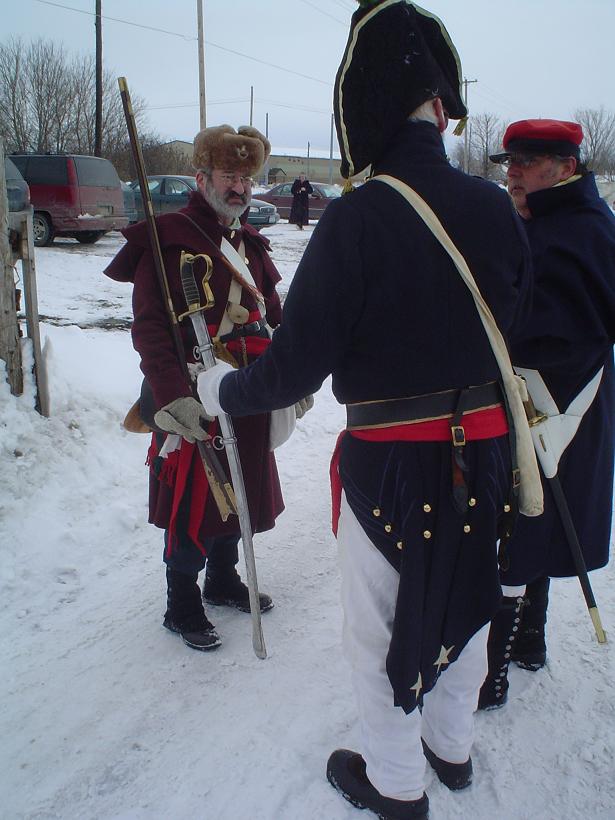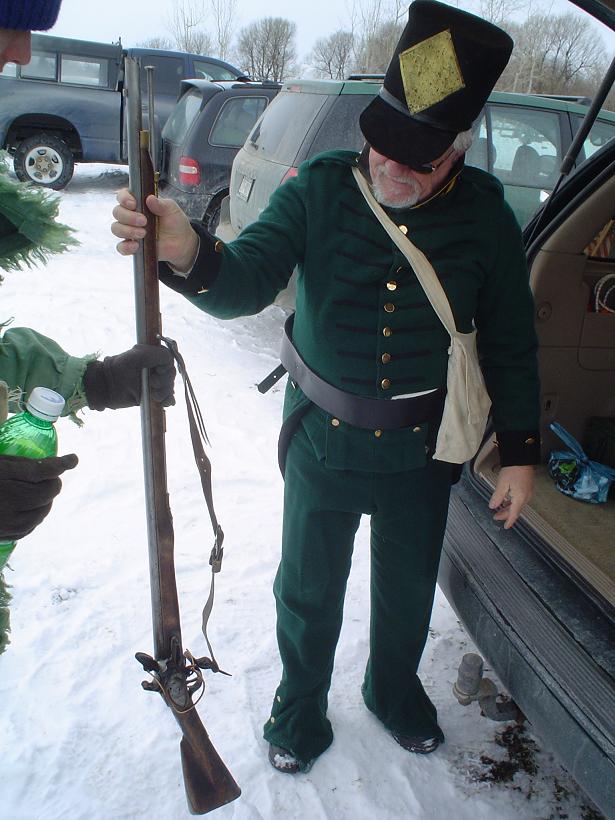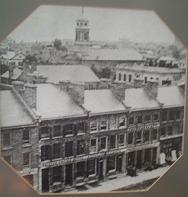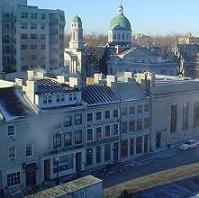 I was told that this is the best booze shack in Watertown, NY. Right next to the Eckerd’s Pharmacy…where you can find the best beer selection in the county. And you thought druggists selling ciggies was weird.
I was told that this is the best booze shack in Watertown, NY. Right next to the Eckerd’s Pharmacy…where you can find the best beer selection in the county. And you thought druggists selling ciggies was weird.
Category: History
Battle of Ogdensburg
We are heading over to beautiful Ogdensburg, 100 km down river on the USA side, for the 14th. Beats the hell out of the Valentine’s Day when myself and herself were amazed at the easy access to the coin laundry machines before we remembered the date.
It is not the reopening of the cheese plant that attracts us. No. It’s the nutty recreationists dressing up like 1812 soldiers for the annual Battle of Ogdensburg re-enactment. Here is the contemporary British view of events. Apparently a group of Newfoundlanders were key to the victory. Here is an American perspective. Pretty big battle with 800 redcoats involved on a direct attack on a US village and fort. Here is a map of the battle. Canadian re-enactors as well as US take part. The area had a mid-1700s French presence and only became the USA in 1796 when the British retreated after the Jay Treaty.
Later St. Lawrence University will play host to Vermont at Canton in NCAA hockey – fewer guns but more real fights.
Men at Serious Play
So we went over to St. Lawrence County, New York, on Saturday to catch a War of 1812 re-enactment of the Battle of Ogdensburg organized by a local group, Forsyth’s Rifles Inc.. We were not disappointed. I had never been to one of these things before – other than being a mock soldier at Citidel Hill in Halifax for one day (I got sun stroke in the shade) – and so in had some pre-conceptions that, on one hand, it would be like a radio nerd convention and, on the other, a bit gungho.
 It was neither. About 60 guys, who could very well have been all high school history from either side of the river/border, played out the actual battle with some authenticity for over about an hour. They were quite happy to answer all questions and made sure everyone kep a safe distance. The grey-coated British advanced over the ice in formation, cannons roared from both sides and fifes were played. It was quite cold and a couple guys said they were considering taking Walmart and holding it instead.
It was neither. About 60 guys, who could very well have been all high school history from either side of the river/border, played out the actual battle with some authenticity for over about an hour. They were quite happy to answer all questions and made sure everyone kep a safe distance. The grey-coated British advanced over the ice in formation, cannons roared from both sides and fifes were played. It was quite cold and a couple guys said they were considering taking Walmart and holding it instead.
I wrote earlier this month on the events and provided links in that post. A year later in the War of 1812, the USA invaded Eastern Ontario and got hammered at Chrysler’s Farm where a much smaller force protected Montreal against 8000 soldiers (including the real Forsyth’s unit) coming up the river from Sackett’s Harbor. There is a bigger re-enactment in summer of that battle which we will likely take in. The Ogdensburg guys head over for that.
Some short movies of the action – all around 2 Mbs so expect some delay
The fifes play as the battle nears
The US forces march out to meet the Brits
a US cannon fires
The US musketmen are ordered to fire at will – note small Brit snowshoe unit coming up to the left in trees
Please give me a heads up if any of the links in the multi-media post do not work.
Three Winter Ales
 These are three great candidates for the best have-one-bottle beer.
These are three great candidates for the best have-one-bottle beer.
Nothing for the faint hearted, though: Young’s Double Chocolate Stout ($3.10 for 500 ml at 5.2%) from London, UK; Victory Storm King Imperial Stout ($2.40 for 355 ml at 9.1%) from Pennsylvania; and Anchor Liberty Ale ($3.55 for 650 ml at 6.2%) from San Francisco and all at the LCBO these days.
Each one is big in its own way – Liberty is massively hopped, Youngs has chocolate malt as well as real chocolate and the Victory is like licking the coffee grinds out of the percolator. Maybe you have to brew to like beers this big but I have so I do. Snazzy labels, too.
Five Hundred
Five hundred posts in around nine months. I received my congratulatory prizes from Portland the other day: a T-shirt from a deep sea fishing outfit from California and a wind-up radio that includes a warning not to wind up until the batteries have had 5 hours charge from a 12 volt adapter (not included). So in honour of the passage of time a side-by-side shot to the southwest from the dome.
Two images of the same view mid-19th century and early 21st
I noticed the older photo down a hallway at work, a view from the dome of City Hall which I have twinned with one of my own from a couple of weeks ago. According to the St. George’s Cathedral history, the older photo must be from between 1838 and 1862 as you can see the second larger dome built in the latter year is not present. So it is around 150 years older than my shot from the other day. The church’s predecessor, more on the actual market square the row of houses to the bottom of each photo face, is the location of the declaration of government in Ontario in 1792:
John Stuart, “Father of the Anglican Church in Upper Canada”, was the Rector. On July 8th, Lieutenant Governor John Simcoe, standing on the steps of St. George’s Church, took “the required oaths” of office and read the Royal Commissions, thus connecting St. George’s with the beginnings of provincial government in Ontario.
The actual date of the first European settlement in Kingston was 1673 by the French at Fort Frontenac. La Salle, the great explorer [after whom a car was named and referenced in the All in the Family theme sung by Archie and Edith Bunker] was the first seigneur and used the fort as a base for his explorations into the interior..which did not turn out all rosy. In 1758 Fort Frontenac was taken by the English. Ransacked and abandoned, it remained unoccupied for the next 25 years. [An interactive map of the entire St. Lawrence area starting with Fort Frontenac in the west from 1776 is here.] In 1783, Major Samuel Holland was sent to survey the condition of the fort, and in the same year temporary barrack facilities were constucted. Sammy is well known in PEI as its first surveyor (though it was only a part of his larger works) and the briefly celebrated namesake of Samuel Holland Institute of Technology (a joke since at least 1993 – scroll down page) which was soon renamed Holland Collage.
Nice Buildings I Like: II and III
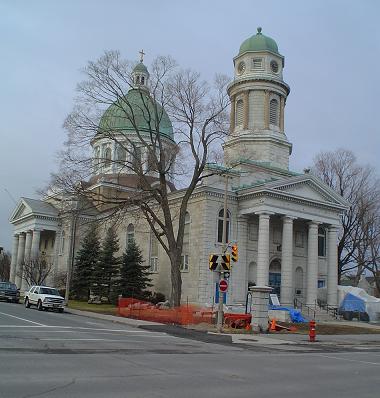 Double domed because they could
Double domed because they could
In the second of a continuing series, I appear to be working out issues I have with domed buildings. This is the head of the Anglican Church in Ontario which sits a couple blocks west of work. There are two parts to it each under its own dome and the foreground one facing King Street East has a dandy smaller dome – verging on cupola – whose gold on black clock faces are quite the thing.
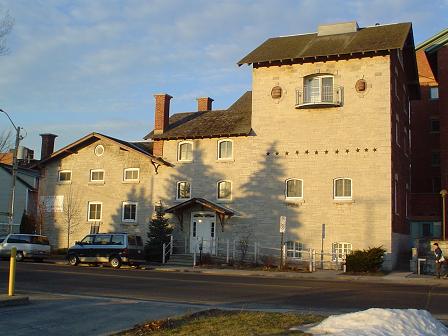 210 years of brewing and office rentals
210 years of brewing and office rentals
Another great building is down by my parking lot on Wellington, north-east of work. This was a brewery – apparently second oldest in Canada according to a picture at the Kingston Brew Pub. The brewery as a company started in 1794 but there was a move back from the street when the public road when through so these buildings are more in the 150 year old area. You can see the tower used in high fallootin’ industrial production of ale in the later end of the 1800’s as it was easier to lift all the ingredients up at the start of production and move them down through mashing, sparging, fermenting, casking, etc.
Die Fax Die
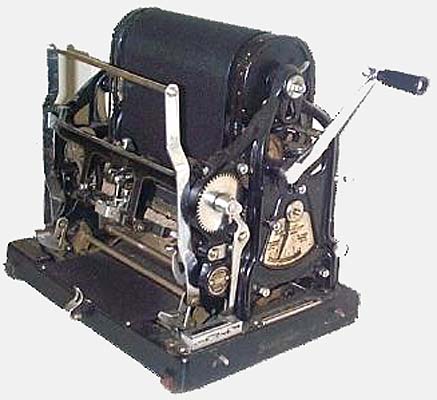
The other day I got an email returned with a reply. Except it was a handwritten reply and the answerer had printed off my email, written his answer on it and faxed it back. It’s folks like that who are ensuring that fax machines continue to clog our lives – pushing up usage 40% in the last year alone.
When will the fax machines die off joining the Gestentner, mother of all ‘zines, itself now hiding its own toxic legacy.
Beer: The Story of the Pint
Last July, I wrote a review of Pete Brown’s book Man Walks into a Pub. Over 7 weeks later, A reply was posted by Martyn Cornell:
I had better declare a massive interest before I begin, since I’m the author of Beer: The Story of the Pint, which came out two months after Pete Brown’s book. I’ve met Pete, he’s a nice guy, and his book contains, in its second half, an excellent analysis of where the brewing industry in Britain is today. It’s a pity the first half does not seem to have had as much research put into it, as it repeats all the old myths about the history of beer my own book attempts to correct – myths which add up to rather more than “a few” factual errors. I wouldn’t ask you to take my word for it – read both books, and let me know what you think.
Before I knew it I shelled out 18.92 Euros through amazon.co.uk and a few weeks ago the book arrived. Paying the $2.20 or so for GST [and the most cursed $5.00 more for the Canada Post GST collection charge – a money grab worthy of Aliant] I ran right home and started into the read.
Now, I have over 30 books about beer. Some are style guides about the history of and how to make, say, Stout or German Wheat Ale. Others are technical works like the ever popular The Biotechnology of Malting and Brewing by J.S Hough (1985, Cambridge)while others are layperson homebrewing guides like the classic 1970’s The Big Book of Brewing by David Line (12th ed, 1985, Amateur Winemaker). Some, like Beer: The Story of the Pint are histories of the phenomena of beer drinking and the brewing industry. I have three or four of these now which focus on the history of the English industry:
Beer and Britannia: An Inebriated History of Britain by Peter Haydon (2001, Sutton)
Beer: The Story of the Pint by Martyn Cornell (2003, Headline)
Man Walks into a Pub by Pete Brown (2003, MacMillan) and
The English Pub by Michael Jackson (1976, Harper & Row).
The latter text is the ish-ish one as it is largely a photo essay on the elements of the pub but it contains as much historical information as any so I include it here. So where does the most recent text fall in?
Lets just say from the outset that I am biased myself as I will buy any book about beer and find something useful in it. In that sense I am speaking as a a collector more than as a book reviewer. Further, I was particularly pleased to be contacted by the author and even more pleased by a continuing email correspondence we have shared. At one point in my reading, I wrote to say that I was somewhat frustrated by the lack of footnoting, to which Mr Cornell replied:
Mmmmm – trouble is, the general feeling in the publishing world is that footnotes equal elitist-looking equals lost sales, except if they’re jokey asides as per Pete Brown’s book. This may be wrong, but it’s what publishers think. The aim of Beer: TSOTP was to try to appeal both to people, like yourself, who already knew a lot about beer and brewing, and also to people looking for a Christmas present for Uncle Ernie (since by getting them to buy the book, I and the publisher make more money …), hence no footnotes so as not to put off the Uncle Ernie crowd. However, to make up for this a little, I tried to make the bibliography as complete as possible, and also chapter-specific, to help people track references down.
Cheers, Martyn Cornell
He is, of course, right…and even knows I have an Uncle Ernie, who lives in the Scottish Borders (blessedly near Traquair House) and who would, indeed, like these books for Christmas. The bibliography provided by Mr. Cornell is extensive, running 14 pages, and wil add muchly to my hunt for more books to buy.
That all being said, it was the first half of the book I enjoyed the most – the history of brewing to very roughly 1850. The latter part I found became a recitation of corporate mergers in the English brewing industry. In the first part a compelling argument concerning the history of porter is set out, the meaning of the XX and KK system described and the pre-1500 story set out more clearly and supported by more extensive research than in any other book I have read. He is, however and for example, lighter on the place of mild from 1850 to 1950 than the others, yet does the best job in explaining Burton. They all, however, miss the best reference to that latter strong ale in Wind in the Willows when Rat and Mole in the chapter “Dulce Domum” discover it in Mole’s old pantry as they prepare a winter night’s feed:
The Rat, meanwhile, was busy examining the lable on one of the beer-bottles. “I perceive this to be Old Burton,’ he remarked approvingly. “Sensible Mole! The very thing! Now we shall be able to mull some ale! Get the things ready, Mole, while I draw the corks.”
Old Burton can be enjoyed in Ontario every winter with the supply of Samuel Smith’s “Winter Welcome” or Young’s “Winter Warmer”, the latter renamed as such in 1971 from the previous “Burton Ale”, as we learn on page 206 of Cornell.
When I compare Cornell’s work to that of Haydon, I find the latter has the better description of 1800 to 1950. Similarly when I add Brown to the mix, he has the best explanation of 1950 to now. What Haydon and Brown achieve is contextualizing the place of beer in English society during those periods, the former in terms of the political and regulatory overlay, the latter in terms of consumerism and marketing. Cornell’s success is setting the greater social context better than the others before 1800 and especially before 1500. My verdict? Buy all of them – and find an old coffee table sized copy of Jacksons The English Pub for more illustrations. Each will add to the others both in terms of the overall timeline and interpretation of particular facts.
The Internet of 1945
The interview with Tim Berners-Lee at BBC news this morning includes reference to the work of Vannevar Bush.
…the idea of hypertext and links had actually been invented some time ago. In fact it was 1945, I think. Vannevar Bush wrote a great paper about how it could be done. But he imagined it all being done using microfilms and electric sensors and mechanics because he didn’t have computers and he didn’t have the internet then, and then Ted Nelson invented the idea of hypertext.
The Atlantic has a 1945 article by Bush on his ideas here where he “urges that men of science should then turn to the massive task of making more accessible our bewildering store of knowledge”
Faskinatin’.
Po-Tree
About twenty years ago right about now, I was entering the third year of my four-year slacker-paced BA in English Lit. I can’t say I have carried the literary banner high since about then, especially as law just about killed my ability to read books – as being an usher in a playhouse just about killed my ability to sit through a play or a movie. But, this being the first summer since 1991 that I have not spent September picking beans, digging up spuds or braiding onions, one poem kicks tricking its way into my mind: Keats’s Ode to Autumn. [Once, when absent mindedly signing up for seminars, one of the others, all-female in romantic poetry, tuned and said – “sorry, I took the last Keats”. I couldn’t recall when I had been aleing with her. I had thought she said “Keith’s”] So, in honour of three years of English Lit classes, the impending season and our planning for the next garden plot in, maybe, 2005, here you are, copyright-free ’cause he’s a long time dead.
Season of mists and mellow fruitfulness,
Close bosom-friend of the maturing sun;
Conspiring with him how to load and bless
With fruit the vines that round the thatch-eves run;
To bend with apples the moss’d cottage-trees,
And fill all fruit with ripeness to the core;
To swell the gourd, and plump the hazel shells
With a sweet kernel; to set budding more,
And still more, later flowers for the bees,
Until they think warm days will never cease,
For Summer has o’er-brimm’d their clammy cells.
Who hath not seen thee oft amid thy store?
Sometimes whoever seeks abroad may find
Thee sitting careless on a granary floor,
Thy hair soft-lifted by the winnowing wind;
Or on a half-reap’d furrow sound asleep,
Drows’d with the fume of poppies, while thy hook
Spares the next swath and all its twined flowers:
And sometimes like a gleaner thou dost keep
Steady thy laden head across a brook;
Or by a cyder-press, with patient look,
Thou watchest the last oozings hours by hours.
Where are the songs of Spring? Ay, where are they?
Think not of them, thou hast thy music too,–
While barred clouds bloom the soft-dying day,
And touch the stubble-plains with rosy hue;
Then in a wailful choir the small gnats mourn
Among the river sallows, borne aloft
Or sinking as the light wind lives or dies;
And full-grown lambs loud bleat from hilly bourn;
Hedge-crickets sing; and now with treble soft
The red-breast whistles from a garden-croft;
And gathering swallows twitter in the skies.
Hmmm… full-grown lambs loud bleat from hilly bourn… time for the mint sauce.



